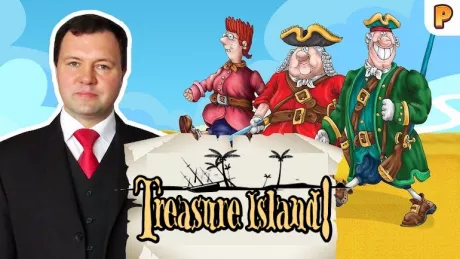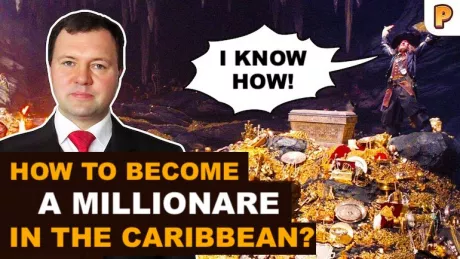
You are reading material prepared during the development of the pirate life simulation game Corsairs Legacy by Mauris studio with the aim of popularizing the marine theme in general and pirate games in particular. You can follow the project news on our website, YouTube channel, and Telegram.
In this material, Kirill Nazarenko tells the story of the famous pirate Henry Morgan, who became the prototype of Captain Blood, the characters of the movie "Pirates of the Caribbean" and the game "Sea Dogs".
Today we will talk about the pirate Morgan. To begin with, a few words about the political situation in Europe, primarily in England in the first half and middle of the 17th century, when Captain Henry Morgan actually acted.

Is Captain Henry Morgan a real pirate? Kirill Nazarenko. Captain Henry Morgan
Let’s recall that Henry Morgan was born in 1635, in Wales, it was a remote area of Great Britain, and soon after Henry Morgan's birth, a civil war broke out in the country.
The first civil war 1642–1646, then after a short break it resumes in 1647–1649. The main opposing sides here were the royalists, led by Charles I, a king who wanted an absolute monarchy. The parliamentary forces opposed the king, which was not immediately, however, but still led by the famous politician Oliver Cromwell.

IIs Captain Henry Morgan a real pirate? Kirill Nazarenko. Politician Oliver Cromwell
He led his side to victory in this civil war, as a result of which King Charles I was executed in January 1649.
A republic was proclaimed in England, it was called the Commonwealth of Nations, that is, such cooperation, and alliance. Now the word "commonwealth" refers to the totality of former colonies of Great Britain, which have retained more or less close ties with the metropolis. But it would be appropriate to say that the "republic" lasted until May 1660. Cromwell had already died by this time, he died in 1658. His son, who inherited his post as de facto head of the republic, was soon overthrown.
A series of military coups take place and, in the end, in May 1660, General Mong restores the monarchy, calling to England the son of Charles I, Charles II, who reigned and ruled after that for 25 years. These events in England are called the Restoration.
However, during the civil war, England was severely split, and Wales belonged to those regions that supported the king, it is clear that some of the inhabitants of these regions after the defeat of the royalists had to be persecuted, but we know very little about the origin of Henry Morgan.
Henry Morgan called himself a gentleman (when he became lieutenant governor). But in England in the 17th century, class boundaries were softer than in continental Europe, and to be recognized as a nobleman, you needed a document. It was impossible to be a nobleman without a piece of paper; while you could be a very poor nobleman, but you had a document about your class status. In England, everything was decided by money, and if you had money to live a gentlemanly lifestyle, and a gentleman is precisely a nobleman in the understanding of the 17-18th century, then you were recognized as a gentleman or a nobleman. If you did not have money, then, accordingly, you were not recognized.
At the same time, in England there was a titled nobility, which stood much higher than ordinary gentlemen, and, of course, there should be a document for the title, but ordinary nobility was a fairly open social category, and wealthy merchants or wealthy peasants could join the ranks of gentlemen. Moreover, in England military service was no longer required from the nobility, and an English gentleman could do anything. However, as a rule, this is still a landowner, although not large in terms of the scale of his possessions.
It is possible that Henry Morgan was not the son of a real gentleman, but was the son of a so-called yeoman.
A yeoman is such a category of wealthy independent peasants who could plow the land themselves, but at the same time possessed a rather large plot of land, and hired laborers.
A lower category — freeholders — are people who rented land from landowners, but on a more or less solid basis. Well, the most disenfranchised category of the rural population is copyholders, that is, those who rented land from the landowner for a short time and on bad terms. Not to mention the laborers, who had no land at all.
Yeomen were distinguished by the fact that they had their land, they did not rent it. The boundary between a yeoman and a gentleman was quite blurred. But, apparently, Morgan still came from some kind of peasant family, still a family of wealthy peasants.
Somewhere in the late 50s (1658–1659), Captain Henry Morgan ends up in America, and he ends up in Barbados. Here it would be appropriate to look at the map of the Caribbean because it is important. Barbados is located in the eastern part of the Caribbean, and it is separated by a fairly large distance from Jamaica, which just at that time becomes the center of British possessions in the Caribbean and the main base of British pirates or corsairs.

Is Captain Henry Morgan a real pirate? Barbados Island
Why does Captain Henry Morgan end up in Barbados? He preferred to remain silent about this, but it is appropriate to recall here that we know quite a bit about Henry Morgan and pirates in general. Because the public office was interested in pirates when the pirates were tried and hanged, and if the pirates were not convicted and hanged, then court documents cannot say anything about them. There is correspondence from the colonial authorities, but the preservation is not very good, and besides, in England in the 17th century the state apparatus was not very well developed.
However, if we compare with France or even with Russia, we will see that in both France and Russia the state apparatus on the ground was more developed, there were more officials, they wrote more papers and control was clearer from the center over the region. Still, it must be said that we know quite a bit about the situation in the remote regions of Siberia in the 17th century from the documentation. In addition, documents perished quite easily.
But in England, bureaucratization was rather weak, and the same governors could write not official reports, say, but private letters to one or another courtier who oversaw the management of these colonies. All this was a rather confusing situation: the documents themselves can be stored not in state archives, as on the usual European continent, but in private collections. In England, there has never been a nationalization of archives, unlike in France, and therefore very important public documents can often be kept in private collections and not be available. Or they may not be stored, the heirs may simply not be particularly interested in them.
Therefore, we know about Caribbean pirates, corsair pirates, and Captain Henry Morgan rather from the middle of the 17th century, and rather from the book of Olivier Exquemelin. Perhaps the Dutchman, who ended up in the Caribbean and joined the pirates, then wrote the book "The Buccaneers of America", which was instantly translated into all European languages, and already in the 60s of the 17th century, it began a long procession across Europe.

Is Captain Henry Morgan a real pirate? Olivier Exquemelin's "The Buccaneers of America"
It is from the stories of Exquemelin that we know about Morgan, Ballon, about and famous pirates of this time. Moreover, modern historians tend to trust Exquemelin, because, in those places where his evidence can be verified, they are verified and turn out to be quite accurate.
Still, why did Captain Henry Morgan end up in America? He ended up in America on bad terms — he sailed on a ship to Barbados and was a slave for three years.
It must be said that in the 17th century in America slavery operated not only against blacks, but also against whites, and white slavery was widespread in the future United States and the Caribbean, in the British colonies, and in the French (but to a lesser extent). At the same time, prisoners and convicts could act as slaves.
How not recall Rafael Sabatini with his novel “Captain Blood: His Odyssey”, which was based on some of the adventures of Captain Henry Morgan. Captain Blood, as you well know, was also convicted of rebellion by the royal court and enslaved and exiled to America.
This was quite common about the unconvicted: just a person who had nothing to pay for the fare signed a contract for three or seven years and worked out this contract on slave terms. The owner paid the carrier for transporting this person, and the slave did not always manage to live until the end of the contract.
However, there are pieces of information (although they are not very reliable) that Captain Henry Morgan was an employee for three years with a certain cutler, that is, a master who made knives in Barbados. This is strange for a very wealthy peasant, or even more so — the son of a gentleman, but anything could happen:
- Morgan could commit some kind of crime and flee to America from the court.
- It is quite possible that he was involved in the events of the civil war. Because in 1958 he was 23 years old, and by the standards of that time, he had to lead an independent life for 8 years.
- He could well have military experience and take part in hostilities, although not in the civil war itself (he was still too young), but in some hostilities of the late 50s.
- He could have been involved in some political intrigue.
However, we do not know this, and Captain Henry Morgan himself kept quiet about this because after the Restoration the situation in England changed dramatically: although an amnesty was announced for all participants in the revolution, except for those who voted for the death penalty for Charles I, ten people were executed cruelly, and the bodies of Cromwell and some of his associates who had already died were removed from their graves, quartered and burned, in retaliation for their actions during the revolution.
Nevertheless, it became simply dangerous to brag about some kind of anti-royal actions after 1660. Therefore, it cannot be ruled out that Morgan managed to participate in something (and yet we do not know anything about it).
We know that he appeared in 1658–1659 in Barbados, then somewhere in 1661–1662 his three-year contract was supposed to expire, he becomes a free man and then quickly finds his place in the ranks of the pirates.
What is happening in the field of politics these years in the Caribbean? In 1654, Cromwell sent a squadron to conquer Hispaniola, but in 1652–1654 the first Anglo-Dutch war took place, a very large serious conflict at sea. It ended, and the English fleet was freed.
Cromwell decided, so that the good would not disappear, to send it to America and conquer some colony there, but the capture of Hispaniola (now the island of Haiti) failed: the Spaniards fought back. Then the British took over Jamaica. It resisted, but the garrison resistance was broken. From 1654 Jamaica actually becomes a British possession, but it was not formalized in any way.
It must be understood that in 1660, after the Restoration, a peace treaty was concluded between Spain and Britain, but this treaty did not specify the situation in the Caribbean. So, the war continued: the Spaniards insisted that only their colonies could be in the Caribbean because America belongs entirely to Spain.
But in fact, Dutch and English colonies appeared on the coast of North America in the middle of the 17th century, these are the future United States. Recall that New York was founded by the Dutch as New Amsterdam, then taken from the Dutch by the British.
And in the Caribbean, Jamaica turned out to be such an important possession: it is located in the very center of the Caribbean Sea next to Cuba and Hispaniola — the heart of the Spanish possessions. In addition, Jamaica is on the way from Portobelo (the Isthmus of Panama) to Havana. Ships passed along this route, carrying treasures that were accumulated in Havana, and from there they went to Spain or Santiago de Cuba, the second largest city on this island. Jamaica is right on that road, and the Spaniards certainly didn't want an English stronghold there.

Is Captain Henry Morgan a real pirate? Kirill Nazarenko. The path in the Caribbean, along which ships carried treasures in the 17th century
Therefore, not only in 1660 but also in 1667, when there was a second attempt to resolve relations, nothing could be agreed upon in the Caribbean Sea.
Only in 1670 was the Treaty of Madrid concluded, according to which Spain comes to terms with the presence of English colonies in the Caribbean, although the ownership of Jamaica by Great Britain was not explicitly spelled out in the Madrid Treaty of 1670. Still, the British have considered Jamaica their official colony since 1670.
Exactly during this period of the incomprehensible legal status of Jamaica, Morgan's activities on this island fall. It is clear that wherever the state was weak, where the legislative base was incomprehensible, where there were no forces to maintain order, all sorts of gangster structures spring up everywhere. You can't dramatize pirates here.
If we talk about some parallels, people who survived the 90s in countries of the former Soviet Union have a good idea of what organized crime and organized criminal groups are. It is clear that if this is a large effective criminal group, it will be well organized, and clearly managed, it will have strict laws and it can actually replace the state: perform state functions, maintain order in a certain territory, fight rival organized criminal groups. The situation was similar in the Caribbean.
Here you need to pay attention to another island. This is the island of Tortuga, which lies off the northern coast of Hispaniola (Haiti). This island was captured by the French.

Is Captain Henry Morgan a real pirate? Kirill Nazarenko. Tortuga Island
Both Jamaica and Tortuga became the main centers of piracy in the Caribbean in the 60s. It must be emphasized that this is not piracy in its purest form, but vacuum piracy - this is corsairs.
All these people receive corsair patents from the English and French authorities, and they are officially considered members of the military, part of the British or French fleet, and they are obliged to capture enemy ships, in this case, the Spanish, to disrupt the enemy’s trade. Corsair pirates are obliged to give a share of the booty to the leadership, but the leadership can theoretically punish them — they can take away their corsair patent. Still, it is clear that the French governor of Tortuga and the British governor of Jamaica did not have very many opportunities, and they had to negotiate with pirates or corsairs, not pressure them.
The years 1650–1660 account for the activities of the famous Allaney, the most famous French pirate of that time, and the activities of Captain Henry Morgan. In 1665, there is the first reliable evidence about Henry Morgan: he is a captain in the squadron of the pirate Mansvelt.

Is Captain Henry Morgan a real pirate? Kirill Nazarenko. Pirate Mansvelt
When they talk about a squadron, they imagine some kind of large sailing ships, but in fact, the pirates operated on very small ships. The largest corsair pirate Henry Morgan ship known to have had a displacement of 120 tons is a tiny shell by modern standards, and by the standards of the 17th century, it is a small, one-two-masted vessel.
Small pirate ships could be about 10–15 tons of displacement — it's just open boats in which it was quite dangerous to swim. But the corsairs were people who were well-oriented and knew how to predict the weather, otherwise, they could not survive in these conditions. Moreover, these are the tropics and not the Arctic Ocean. Here, if it is not the season of storms, it’s a little simpler.
It is not necessary to think that Captain Henry Morgan commanded hundreds of people in 1665 — there were several dozen pirates on this small ship, but the fact that Morgan was the chieftain of such a gang already indicated that he was an authoritative person and stood out among his associates.
At the end of 1667 - at the beginning of 1668, Mansfield died (he was captured and executed by the Spaniards, or may have been poisoned), there is no reason to connect Mansfield's death with Morgan. After the death of Mansfield, his gang chooses Henry Morgan as their admiral, he becomes the head of a large pirate rank of several hundred people. This is indeed a powerful force because the garrison of large forts in the Caribbean consisted of several hundred soldiers, and with so many pirates, big things could be done.
If we talk about Captain Henry Morgan's experience, it is reliably known that he went on a campaign to Trujillo and Granada, the Spanish cities under the command of Mansfield. Then Mansfield tried to attack the Spanish possessions in Cuba and was defeated.
What were the Spanish possessions in America? They were very large, and the Spaniards could not protect every bay, every village on the coast. Their strengthening, the troops were concentrated in several key points of the colonial possessions, and the Spaniards experienced several stages of strengthening these colonial possessions.
For the first time, the Spaniards faced serious danger during the time of Francis Drake - this is the beginning of the second half of the 16th century. When the first English attacks on Spanish possessions happened, the Spaniards began to build some kind of stone forts for the first time, arming them with more or less decent artillery. However, on the Pacific coast, by the way, before that there weren’t even wooden fortifications at all, because the Spaniards believed that no one would get there.
But the events of the 50s–60s of the 17th century pushed the Spanish authorities to a new fortification construction. During these years, a lot of forts were built that looked like real European regular fortresses, such as fort Charles, which was built by the British in the same years.

Is Captain Henry Morgan a real pirate? Kirill Nazarenko. Fort Charles
There is a plan for the city of Port Royal in Jamaica, it was a large city by the standards of the Caribbean, with as many as 7,000 people, at a time when the scale of European capitals has hundreds of thousands of people.

Is Captain Henry Morgan a real pirate? Kirill Nazarenko. City plan of Port Royal in Jamaica
The population of London or Paris had passed half a million by this time and was beginning to move towards a million. There were many cities in Europe with a population of over 100,000 people. And here the city with a population of 7,000 was considered a very large and important city in Jamaica, and in general, the largest city of the English possessions of that time in America.
The Spanish cities were a little larger: 15–20 thousand people lived in Santiago de Cuba or Havana, but one must understand that these were small cities.
Port Royal was surrounded by five forts on all sides, located on a cape, so it was difficult to attack it from land, but it was also well protected from the sea.

Is Captain Henry Morgan a real pirate? Kirill Nazarenko. City of Port Royal 17th-18th century
Spanish possessions, in general, also had some defensive structures by this time. For example, the tower in Old Panama is more of a bell tower than a fortress tower.

Is Captain Henry Morgan a real pirate? Kirill Nazarenko. Tower in Old Panama
The Spanish batteries and forts which Morgan then stormed at Santiago de la Gloria on the Isthmus of Panama; or a fortress (fort) in San Lorenzo, also on the Isthmus of Panama.

Is Captain Henry Morgan a real pirate? Kirill Nazarenko. Fort at San Lorenzo on the Isthmus of Panama
This fortress has an absolutely regular structure: two semi-bastions, covered in front with a provelyn — a special fortification that protects the approaches. Cannons are installed on it and it has a regular hexagonal shape. These were not some makeshift fortifications, but quite regular fortifications. They could be armed with a small number of guns, which were quite old because all the best went to Europe. There were no serious armies, large ones, with siege artillery in the Caribbean Sea. Still, for defense against pirates, these fortifications were more than worthy.
The battery in Santiago de la Gloria was also quite regular and had the correct appearance. However, any fortress is a force only if it is defended — if the garrison in the fortress is weak or there is not enough ammunition, then the defense force of such a fortress will be very small.
Let's return to the adventures of corsair Captain Henry Morgan. There is an image of Morgan, although it is rather late — this is the original black and white engraving from Esquemelin's book "The Buccaneers of America", there is also a colored engraving, although it cannot be ruled out that this is a fantastic image.

Is Captain Henry Morgan a real pirate? Kirill Nazarenko. Captain Henry Morgan. Black and white engraving from Esquemelin's book "The Buccaneers of America"
Captain Henry Morgan, having become a pirate admiral, begins his independent activity. From the very beginning, in 1668, he began to attack the city of Puerto Principe in Cuba, and in March he landed at Puerto Principe (now the city of Camagüey). There he defeated a small Spanish detachment, after which the city surrendered. Morgan demanded a ransom of 50,000 pesos and 500 head of cattle in order to replenish food supplies. The Spaniards believed that the commandant of the city was to blame, and the authorities, who surrendered instead of defending themselves, were to blame.
This is a typical story: you don’t need to draw the Spaniards with some kind of wooden dummy, of course not, but the service in the colonies was hard and not prestigious, there were not the best military leaders. The most active commanders, of course, were used in Europe, and the colonies served as a place of exile for Spanish officers who were guilty of something or did not show themselves very well. In addition, the opportunity to curry favor and the opportunity to distinguish themselves in the colonies was extremely small. It was vegetating, like exile to Siberia: a person was exiled in the eighteenth century, maybe a boss, but being a governor in Siberia was much worse than being a governor somewhere in the European part of the country. And therefore, one should not think that the Spanish chiefs who opposed the pirates were all geniuses.
On the other hand, the pirates were very active people, they had the initiative in their hands, and they chose the place and time for attacks, and the Spaniards had to wait all the time, and prepare, not knowing when they would be attacked.
Accordingly, after this sacking of Puerto Principe, it is characteristic that corsair Morgan does not return to Cuba anymore, because Cuba and Espanola were too tough for pirates at that time. So, he transfers his efforts to the Isthmus of Panama, where, in particular, he attacks the city of Portobelo (in our time, Costa Rica), while the assault could be repulsed by the Spaniards, but the Spaniards at some point despaired and surrendered. Part of the Spanish soldiers continued to defend themselves together with the governor, and they died.
After Portobelo was captured, the governor of Panama tried to recapture it, but was defeated, and he still left, collecting a ransom. At the same time, the Spaniards had the idea that it would be possible to move to Panama.
Portobelo is located on the north coast of the Isthmus of Panama on the Caribbean Sea. Panama is located on the Atlantic Ocean on the southern coast of the isthmus, and Panama was very important — it was a transit point for silver, which was mined in Peru and brought to Panama by sea, then transported across the isthmus and then transported to Cuba and Spain.

Is Captain Henry Morgan a real pirate? Kirill Nazarenko. The path in the Caribbean, along which ships transported silver in the 17th century
And so the idea that it was possible to capture Panama came to the pirates' minds.
In terms of booty, they seized about 500 pesos, or piastres, or thalers per person.
Thaler is a silver coin, weighing 27.2 grams of pure silver, but the real weight was more because the silver was not pure, and this rather large coin, larger than the anniversary ruble of the Soviet era, the diameter of the thaler is slightly more than 40 millimeters. It is rather thick.
As for the purchasing power of the thaler, it should be noted that the English sailors received about six thalers a month in the merchant fleet in these years. This was a very high wage for a day laborer because people who worked on the land as diggers or construction workers received 1–2 thalers a month and this was considered sufficient payment for their work, and for 1–2 thalers a month they were fed, clothed (really bad).
Soldiers in England, for example, received at that time two pence a day, or 60 pence a month - that would be five shillings, or just exactly one thaler a month.
Therefore, a bounty of five hundred thalers is quite a lot, on the one hand, but on the other hand, prices in the Caribbean were ten times higher than in Europe, so it is impossible to say that 500 thalers are some kind of outrageous amount. It was impossible to start a new life with this money, they could be drunk away, perhaps.
Further, there was an idea to attack Panama, and corsair Captain Henry Morgan begins to prepare for this expedition.
At the beginning of 1669, he gathers an expedition, but in the end, he attacks not Panama, but Maracaibo — this is another major Spanish city in Venezuela, which is located on the shore of the channel leading to the large Lake Maracaibo.

Is Captain Henry Morgan a real pirate? Kirill Nazarenko. The city of Maracaibo on a 17th-century map
Before entering this channel there is a rather narrow passage with several islands. There were several forts there, but the pirates were able to overcome these obstacles, and it must be said that Captain Henry Morgan is undertaking a raid on Maracaibo, like a royal corsair, his squadron is reinforced by the royal frigate Oxford. The largest pirate ship that participated in the expedition came from Tortuga, it was a French ship, the frigate “Kite”, armed with 24 guns. It was a relatively small frigate.
In the spring of 1669, French and English pirates captured Maracaibo with a sudden blow. But at that moment, a Spanish squadron of three ships approached the channel, they captured Fort La Barra, which the pirates had taken, and thus locked Morgan's squadron in the bay.
Captain Henry Morgan was offered to return the loot, free the captive slaves and leave. But the pirates refused to do so because then they would have left naked, barefoot, and that would have been very shameful. As a result, they tried to bargain, but the Spanish admiral did not bargain, and as a result, at the end of April, the pirate squadron made a breakthrough.
The Spaniards launched a fireship, and it was able to grapple with the Spanish flagship and set it on fire, two other Spanish ships tried to withdraw, but one ran aground, and the other was boarded, and thus Captain Henry Morgan broke through. But he broke through not into the open sea, but into another section of the channel, which locked the fort with six guns. Then corsair Morgan embarked on a trick: he pretended to want to storm the fort from land. The Spaniards dragged 6 cannons that were in this fort to the land side, after which Morgan broke through.
This episode was described in Sabatini's novel “Captain Blood”, and about 250 thousand thalers were captured, but in the end, one person had half as much as after the previous campaign. Despite all these military exploits, each pirate earned somewhere between 200–250 thalers, which was not very much, although the fame of Henry Morgan went widely.

Is Captain Henry Morgan a real pirate? Kirill Nazarenko. Is Captain Henry Morgan a real pirate?Rafael Sabotini “Captain Blood”
At the same time, after this raid on Maracaibo, the corsairs found themselves in a difficult situation, because in 1667 another Anglo-Spanish treaty was concluded, and the governor of Jamaica was ordered to stop issuing corsair patents.
It is clear that information about everything reached the Caribbean after some time. Moreover, the governors themselves necessarily took a certain timeout, pretending that the information reached them even later, but in any case, after Morgan returned, he would not be able to renew the patent.
But in 1670, the Spaniards attacked the north coast of Jamaica, so Captain Henry Morgan was granted a patent by the Council of this island. Again, it is characteristic that in England the state apparatus was weak, and the local governments had a strong enough will to wage private war. As a result, Morgan again invited the French, and together with the French from Tortuga they united, after which they now moved to the Isthmus of Panama.
This was the third, perhaps the most famous campaign of Captain Henry Morgan. They approached the Spanish coast in December 1670 and captured a Spanish fort on the coast. Then they found guides in order to move to Panama.
On the map there is an image of the route of communication in the Spanish possessions of this time, there were several ways to Panama: you can move through Portobelo, from a point called Chagres (now the city of Colon) on the coast of Panama. Corsairs take possession of several Spanish forts and begin to move across the isthmus. Despite the presence of guides, the progress was difficult, the pirates were quite hungry because they could not go all the way on the boats, as a result, they still went to Panama and attacked it.
Panama was one of the largest cities in the new world: there were more than 2000 houses and somewhere between 10–12 thousand people were there. Allegedly, there were 700 cavalrymen and 2000 infantrymen in the garrison (most likely, these figures were only on paper, such a garrison could hardly be located in a city with 10-12 thousand people).
2700 soldiers — this number can be real if you include the militia of the city's population. It is clear that the townspeople were not good warriors and, although they were constantly used in the defense of the fortress, it was difficult for them to fight in an open field. Their skills were not very good, and the pirates, of course, were professional fighters.
As a result, the pirates were able to defeat a detachment of Spaniards under the walls of Panama, and rushed to storm the city, while losing only 20 people beaten and the same number of wounded. This means that the resistance was very weak. At this time, a fire broke out in the city.
Someone accuses Captain Henry Morgan that he set fire to Panama. But this is strange, because, it would seem, it was necessary to capture the booty, and not set fire to the city. However, it is more likely that the Spaniards set fire to the city so that the pirates did not get anything and burned large food supplies, nevertheless, some stocks remained and therefore the pirates fed themselves in the city and felt quite comfortable. But some of the pirates decided to pirate in the Pacific Ocean, seizing the ships that were on the roads of Panama, but Morgan forbade them to do this.
In February 1671, a caravan left Panama with about 150 mules loaded with silver. You can estimate that the load on one mule is somewhere around 120 kilograms maximum. That is, if it was 150–160 mules, then one can imagine that they could transport somewhere up to 18–20 tons of cargo (there is no reason to believe that all this cargo was pure silver or gold, there were quite a lot of goods, but when the pirates calculated — they shed tears because ordinary pirates received 200 thalers each).

Is Captain Henry Morgan a real pirate? Kirill Nazarenko. Thalers
There is one more important point: the term “peso” is usually used when it comes to the plunder of the Spanish colonies, theoretically, this term should be understood as “thaler”, but in Spanish, there is the word “pesetta” — this is 1/8 thaler or 1/8 peso, another name for peseto is “real”, but do not confuse real and real-develop, do not confuse with another monetary unit of Spain of that time “real-de-plata”, which was equal to one and a half real-develop. In principle, real-de-plata can also be called pesos, then it turns out that there were about five and a few pesos in the thaler.
There is evidence that an ordinary pirate received 200 pesos or ten pounds sterling, a pound sterling is four thalers. It turns out that 200 pesos are not a peso, but a real-de-plateau, that is, a silver real. Thus, if converted into thalers, the most popular currency of that time, then the pirates receive only 40 thalers, which was not much at all. That's the salary of an English merchant seaman for a little over a year. It is clear that after such tension, and such military exploits, it was not very serious to receive an annual salary of a merchant sailor.
Hence the rumors that Captain Henry Morgan stole the booty and supposedly he went on the Mayflower ship with three more ships and stole the bulk of the treasure. But the pirates were not the kind of people who could be thrown out of the blue like that. Therefore, most likely, it was like this: Captain Henry Morgan expected to find another consignment of silver from Peru in Panama and prepared for transportation to Spain, but he did not find this consignment. Having plundered Panama, he could only plunder the property that the inhabitants of this city had, and some amounts that were in the local treasury, were not very large, and the booty did not justify the efforts that were made.
But on the other hand, Morgan's fame rose to a new level, and then he returned to Jamaica. But this return was very difficult because just at that time (shortly before Captain Henry Morgan left Jamaica) the Madrid Treaty of 1670 was signed between Spain and England, which more or less settled their relations for the next 30 years. Therefore, the king and his government were interested in not aggravating relations in the Caribbean, especially since Spain actually recognized Jamaica as an English colony.
An investigation is being launched into Captain Henry Morgan, it is possible that this investigation was carried out quite energetically, also because the production from Panama was not as large as expected. According to Spanish documents, it seems like all the money that was deposited in Madrid this year was transported without much loss.
Then Morgan is sent to England in 1672, for some time he is under house arrest, and in the end, Morgan was justified. All this was quite natural because in England they were accustomed to turning a blind eye to the activities of their colonial activists who plundered Spain. Morgan receives a knighthood and the position of Lieutenant Governor of Jamaica, in addition, he married, and in 1679 received the position of Chief Justice of Jamaica.
Henry Morgan himself did not drink his money, he invested it in the estate, and he became the owner of two sugar plantations, which were processed by slaves. On the way back to Jamaica, Henry Morgan almost died during a shipwreck, but nevertheless, he got to Jamaica and continued to patronize his old friend to a certain extent, but on the other hand, he could not patronize.
In 1682, Henry Morgan was again accused of abuse of office, embezzlement, and a black streak began in his life again.
In England in 1685, the book "Pirates of the Americas" was published, where the exploits of Captain Henry Morgan were painted, in addition, King Charles II died in the same year, and his brother James II, who professed Catholicism and occupied a pro-Spanish position, took the throne.

Is Captain Henry Morgan a real pirate? Kirill Nazarenko. Olivier Exquemelin "The Buccaneers of America"
Captain Henry Morgan had certain problems, but by this time Morgan himself was so convinced that he had always been a respectable person that he even started a lawsuit against the publishers of Exquemelin's book, accusing them of slander, demanding a very large amount for moral damage, but as a result, moral damage was rated very low by the court: Captain Henry Morgan demanded 10,000 pounds, and in the end received only 200 pounds. Converting this to thalers, 10,000 pounds is 40,000 thalers, and 200 pounds is 800 thalers.
After that, Henry Morgan did not return to public office and died in 1688, most likely from cirrhosis, because he drank heavily. He was buried in the cemetery at Port Royal. He died at an age far from old by modern standards, 53 years old, but at the time of the 17th century, it was a fairly respectable age.
The posthumous fate of Captain Henry Morgan, who was buried in the cathedral of Port Royal, was quite amusing. Four years later, in 1694, a terrible earthquake destroyed Port Royal, a tsunami hit the shore and Morgan's grave disappeared. At the same time, local moralists believed that God punished Port Royal, as once Sodom, and Gomorrah, because Port Royal was a nest of depravity and lawlessness in the Caribbean — a completely symbolic end.
Moreover, Captain Henry Morgan remained in literature, thanks to Exquemelin, with whom he sued, and thanks to art books that were written under the influence of his biography. First of all, this is the Captain Blood: His Odyssey by Rafael Sabatini.
We hope you found this article useful!
Learn more about the Corsairs Legacy - Historical Pirate RPG Simulator project and add it to your wishlist on the game's Steam page.




















